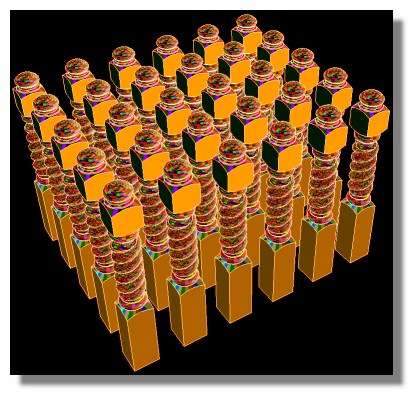Barley Twist Spirals
-
@gilles said:
Here is your model with some corrections and the use of components,note it is 650Kb instead of 1950.
Looks better than mine. So you redid the spiral?
-
@unknownuser said:
@unknownuser said:
found a situation where a group made more sense than a component.
You have some plugins who works only with groups!

You're right. And when I use them I wind up converting the groups to components. I'd be happier if a component was just created by the plugin.
I haven't found a need to use any plugins that only work on groups.
-
@dave r said:
Gilles version of your model illustrates very clearly the reduction in file size that I mentioned earlier.

And even 100 of them is only 820 Kb. That's a couple of hours of production in your shop, right?
Wish I could make them that fast. I missing something - would like to know your work flow on the spiral
-
I'd be happy to show you. I can't do it at the moment, though. Maybe another live demo with you or I'll make a video.
-
@unknownuser said:
found a situation where a group made more sense than a component.
You have some plugins who works only with groups!

-
@dave r said:
I'd be happy to show you. I can't do it at the moment, though. Maybe another live demo with you or I'll make a video.
Dave
That'd be great!! -
and here for example after explode the original component for paint each faces
I don't need to make a component again, but just a group!

-
-
-
I just want to thank you all for this thread. It has been a great learning experience.

-
-
This thread is hot! Another point I would make is with screw.rb one can then make a component of spiral section that would stack directly beneath the other (without turning) and so you could increase, vary the height (within a module) easily.
I assume that can be done with Gilles' version.
-
Yes we can!
huhu couldn't resist.
-
@pbacot said:
This thread is hot! Another point I would make is with screw.rb one can then make a component of spiral section that would stack directly beneath the other (without turning) and so you could increase, vary the height (within a module) easily.
I assume that can be done with Gilles' version.
If I understand you right this is one method I used - I made a 2 1/2" profile (the profile of my barley twist router cutter) then used the screw plugin to make a 5" high one revolution spiral. I grouped it, then copied and stacked it on top the other spiral. I then selected those to array the rest of the way.
-
That's pretty much it but use a component instead of a group.
-
@dave r said:
That's pretty much it but use a component instead of a group.
Still not sure why there is such a difference in file size -
I believe it's quasi the same size maybe a little less for the group because there is less informations inside no Glue etc..., but same info as pure geometry.
-
@unknownuser said:
illes wrote:
Here is your model with some corrections and the use of components,note it is 650Kb instead of 1950.Isn't it a big difference?
Also modifying all instances at once.
Create libraries for further use in other models. -
Re: file size of my barley twist stair newel
I'm still perplexed by the size of my file. I started over with a new SU file and made my newel without the barley twist. After imported my profile from CAD, did a sweep, created a component of the newel and my file size is 3 MB. What gives?
BTW I have purged layers from the CAD file import -
How many segments did your imported profile turn out to have? The profile I created last night with the Bezier tool had 22 (including the two little short segments I added at the ends. And the total number of entities after one turn of the screw was 2686.
Advertisement








